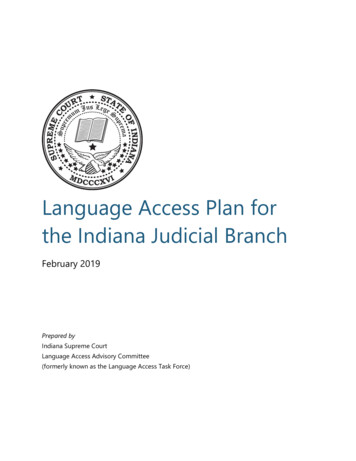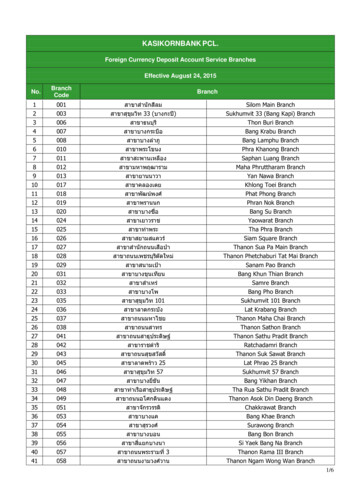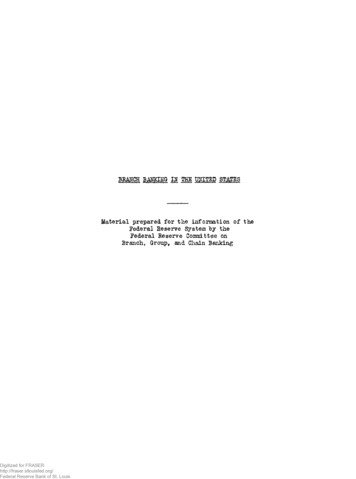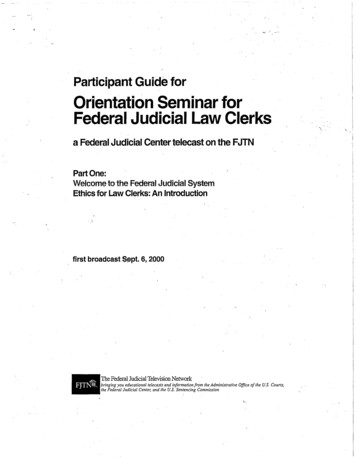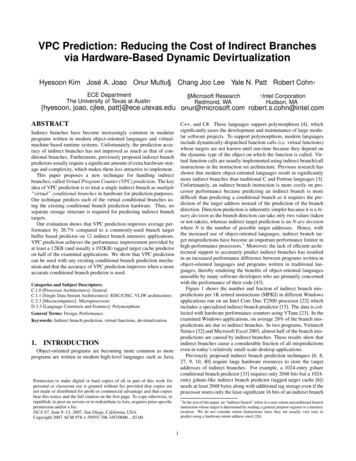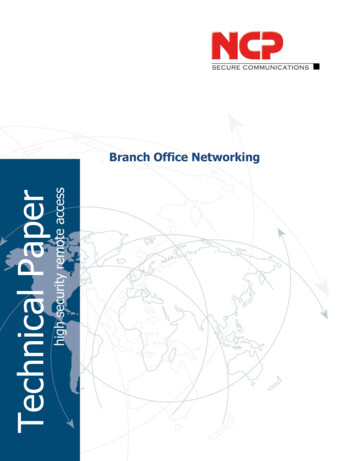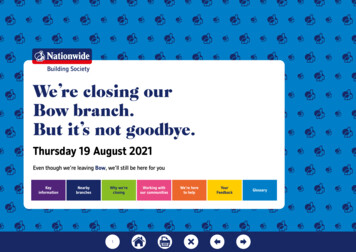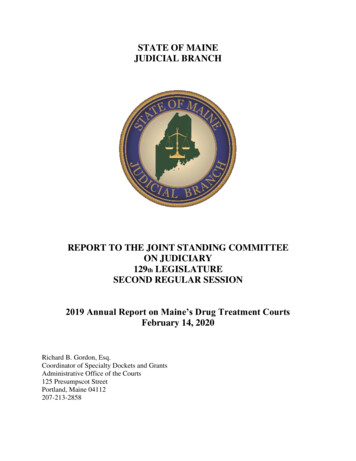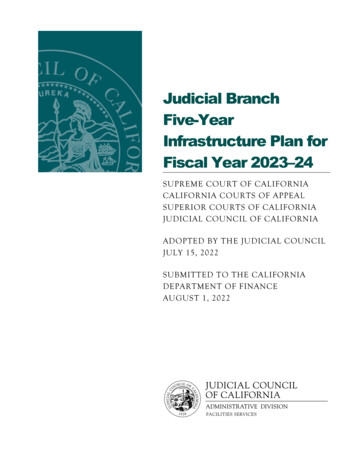
Transcription
Judicial BranchFive-YearInfrastructure Plan forFiscal Year 2023–24SUPREME COURT OF CALIFORNIACALIFORNIA COURTS OF APPEALSUPERIOR COURTS OF CALIFORNIAJUDICIAL COUNCIL OF CALIFORNIAADOPTED BY THE JUDICIAL COUNCILJULY 15, 2022SUBMITTED TO THE CALIFORNIADEPARTMENT OF FINANCEAUGUST 1, 2022
TABLE OF CONTENTSINTRODUCTION . 1REASSESSMENT OF TRIAL COURT CAPITAL-OUTLAY PROJECTS . 2A. Process . 2B. Statewide List of Capital-Outlay Projects . 2C. Revision of Prioritization Methodology . 3INTEGRATING CLIMATE CHANGE INTO PLANNING AND INVESTMENT . 3EXISTING FACILITIES . 4DRIVERS OF INFRASTRUCTURE NEEDS . 4PROPOSAL . 5A. Trial Court Capital-Outlay Project Funding Requests for FY 2023–24 . 5Table: Five-Year Plan for Trial Court Capital-Outlay Projects . 6B. Appellate Court Capital-Outlay Project Funding Requests for FY 2023–24 . 7Table: Five-Year Plan for Appellate Court Capital-Outlay Projects . 7ATTACHMENT AStatus Report: Immediate and Critical Need Trial Court Capital-OutlayProjects (July 15, 2022)ATTACHMENT BGovernor’s 2022 Infrastructure Capital Funding Plan (Jan. 10, 2022)i
INTRODUCTIONThe California judicial branch consists of the Supreme Court, Courts of Appeal, trial courts, andthe Judicial Council. The Lockyer-Isenberg Trial Court Funding Act of 1997 (Assem. Bill 233;Stats. 1997, ch. 850) consolidated the costs of operating California’s trial courts at the state level.The act was based on the premise that state funding of court operations was necessary to providemore uniform standards and procedures, economies of scale, structural efficiency, and access forthe public.Following on this act, the Trial Court Facilities Act of 2002 (Sen. Bill 1732; Stats. 2002,ch. 1082) specified that counties and the state pursue a process that would ultimately result infull state assumption of the financial responsibility and equity ownership of all court facilities.To address maintenance costs in existing court facilities and the renovation or construction ofnew court facilities, the Trial Court Facilities Act required counties to contribute to the ongoingoperation and maintenance of court facilities based on historical expenditures for facilitiestransferred to the state. The act also established a dedicated revenue stream to the State CourtFacilities Construction Fund for the design, construction, or renovation of these facilities.Recognizing the growing demand to replace California’s aging courthouses, additionallegislation was enacted. Senate Bill 1407 (Stats. 2008, ch. 311) authorizes various fees, penalties,and assessments to be deposited in the Immediate and Critical Needs Account (ICNA) to supportthe construction, renovation, and operation of court facilities, including the payment of rentalcosts associated with completed capital-outlay projects funded with lease revenue bonds.However, these revenues have been lower than expected, which led to the curtailment of theJudicial Council’s capital program.On June 27, 2018, when the 2018 Budget Act was passed, the judicial branch courthouseconstruction program was allocated 1.3 billion for the continuing phases of 10 trial courtcapital-outlay projects in the following counties: Glenn, Imperial, Riverside (in both Indio and inmidcounty regions), Sacramento, Shasta, Siskiyou, Sonoma, Stanislaus, and Tuolumne. Thishighly encouraging support for the construction program also memorialized a notable change inthe program’s source of funding: The sale of lease revenue bonds to finance a project’sconstruction was backed by the General Fund rather than the ICNA. Since 2008, SB 1407projects had relied on the ICNA, which is forecasted to have a negative fund balance as early asfiscal year (FY) 2026–27 owing to the continual decline of its sources of revenue of fines andfees. In FY 2021–22, for the State Court Facilities Construction Fund (SCFCF)—the othersource from which the courthouse construction program is funded—to remain solvent and theJudicial Council to maintain program service levels, the ICNA and SCFCF were combined.The Judicial Council completed facility master plans for each of the 58 counties inDecember 2003. Those plans were consolidated into a statewide plan approved by the JudicialCouncil in February 2004 as the Trial Court Five-Year Capital-Outlay Plan, which ranked201 projects for future development. Changes to this initial statewide plan have been approvedincrementally since 2004. The most recently developed statewide list of trial court capital-outlay1
projects and the five-year plan for trial court capital-outlay projects are described below andattached to this report.REASSESSMENT OF TRIAL COURT CAPITAL-OUTLAY PROJECTSGovernment Code section 70371.9 required the Judicial Council to conduct a reassessment of alltrial court capital-outlay projects that had not been fully funded up to and through the2018 Budget Act (FY 2018–19) and to submit the report by December 31, 2019, to twolegislative committees. This reassessment produced the Statewide List of Trial Court CapitalOutlay Projects prioritized on needs-based/cost-based scores from the application of thecouncil’s Revision of Prioritization Methodology for Trial Court Capital-Outlay Projects.A.ProcessThe reassessment of the capital-outlay projects can be summarized by five main endeavors:1. Revision of the prioritization methodology—developing needs-based criteria and costbased criteria to rank projects within priority groups—consistent with Government Codesection 70371.9;2. Assessment of facilities occupied by trial courts, including physical conditionassessments, as well as assessments related to security, access to court services, andovercrowding;3. Development of court facility plans and court needs-based projects;4. Application of the prioritization methodology to all projects; and5. Development of a statewide list of prioritized projects.B.Statewide List of Capital-Outlay ProjectsThe Statewide List of Trial Court Capital-Outlay Projects has been developed from theapplication of the revised prioritization methodology to the capital projects identified by thecourt facility plans, of which there is one for each county. As defined in the methodology, trialcourt capital-outlay projects are considered those that increase a facility’s gross area, such as abuilding addition; that substantially renovate a major portion of a facility; that comprise a newfacility or an acquisition; or that change the use of a facility, such as the conversion fromnoncourt use to court use.Details of the list are as follows: There is a total of 80 projects for 41 of the 58 trial courts. All 80 projects affect 165 of the approximate total 450 facilities in the judicial branch’sreal estate portfolio.2
The total cost of each need group is Immediate, 2.3 billion; Critical, 7.9 billion;High, 1.3 billion; Medium, 1.6 billion; and Low, 0.1 billion. Of the 80 projects, 56 are for new construction, and 24 are for renovation and/or addition. The total cost for the 56 new construction projects is estimated at 10.6 billion; the totalcost for the 24 renovation and/or addition projects is estimated at 2.6 billion. The total cost of all 80 projects is estimated at 13.2 billion.C.Revision of Prioritization MethodologyThe methodology involves a two-step process: 1 Step 1 identifies (1) the general physicalcondition of the buildings; (2) needed improvement to the physical condition of buildings toalleviate the totality of risks associated with seismic conditions, fire and life safety conditions,Americans with Disabilities Act requirements, and environmental hazards; (3) court securityfeatures within buildings; (4) access to court services; (5) overcrowding; and (6) capital-outlayprojects that replace or renovate courtrooms in court buildings where there is a risk to court usersdue to potential catastrophic events.Step 2 involves applying the needs-based criteria and cost-based criteria to rank projects withinthe priority groups.In the most essential terms, the methodology can be described as: Needs-based criteria Priority Group; andNeeds-based and cost-based criteria Rank within Priority Group.INTEGRATING CLIMATE CHANGE INTO PLANNING AND INVESTMENTThe Judicial Council has supported climate adaptation and sustainability practices in theconstruction, operations, and maintenance of approximately 450 court facilities that houseCalifornia’s court system. The council’s capital program focuses on proven design approaches andbuilding elements that can improve court facilities and result in cost-effective, sustainablebuildings. Strategies include protecting, conserving, and restoring water resources; installing waterreuse systems; and improving energy efficiency. Other strategies include promoting a healthyindoor environment, using environmentally friendly building materials, recycling materials duringconstruction and demolition, and using flexible designs that anticipate future changes andenhance building longevity. The Judicial Council also designs its buildings to achieve at leastLEED (Leadership in Energy and Environmental Design) Silver certification equivalency.For more detailed information, see Judicial Council of Cal., Advisory Com. Rep., Court Facilities: Reassessmentof Trial Court Capital-Outlay Projects (Nov. 5, 2019), agenda item 19-129 of the Judicial Council meeting ofNov. 14, 2019, https://jcc.legistar.com/View.ashx?M F&ID 7862663&GUID C63B6E8E-6A8D-476C-BF8F634132CB381F.13
In December 2020, the Judicial Council’s Trial Court Facility Modification Advisory Committeeapproved a sustainability plan that focuses primarily on ensuring that new construction practicescomply with state sustainability initiatives and help reduce the judicial branch’s impact onclimate change. Additional goals include reducing greenhouse gas emissions, energy usage, andutility costs by pursuing energy efficiency measures such as leveraging grant opportunities andthird-party financing options; educating staff, key stakeholders, and service providers on specificenergy-saving practices and broader sustainability issues; conserving other natural resourcesthrough improved data collection and baseline tracking; and improving the power resiliency ofthe judicial branch’s portfolio through onsite renewable energy generation and storage systems.EXISTING FACILITIESThe facilities of the Supreme Court, Courts of Appeal, and trial courts encompass not only thepublic courtroom spaces, but also the chambers and workspace where judicial officers andcourtroom staff prepare for proceedings; secure areas, including holding cells; and buildingsupport functions.The trial courts are located in each of the 58 counties, in approximately 450 facilities and2,100 courtrooms, covering approximately 16 million square feet of usable area and more than21 million square feet of space under Judicial Council responsibility and management.The Courts of Appeal are organized into six districts, which operate in nine different locations inapproximately 508,000 square feet. The Fresno and Riverside appellate courts are housed instandalone, state-owned facilities with the balance being co-located in other leased or stateowned space.The Supreme Court is located in the Civic Center Plaza in San Francisco (103,300 square feet) andin the Ronald Reagan State Building in Los Angeles (7,600 square feet).Currently, the Judicial Council administrative facilities are located in San Francisco andSacramento, with office space totaling approximately 263,000 square feet.DRIVERS OF INFRASTRUCTURE NEEDSThe primary drivers of court facility needs include providing a safe and secure facility,improving poor functional conditions, addressing inadequate physical conditions includingseismically deficient facilities, and expanding access to justice. Addressing these needs isconsistent with the Chief Justice’s Access 3D initiative to expand and improve the public’sphysical, remote, and equal access to the courts.4
PROPOSALA.Trial Court Capital-Outlay Project Funding Requests for FY 2023–24The five-year plan for trial court capital-outlay projects in the table below proposes funding inFY 2023–24 for six projects on the Judicial Council’s approved statewide list of projects asreferenced in the Status Report: Immediate and Critical Need Trial Court Capital-OutlayProjects (see Attachment A). This proposal is based on funding support in the Governor’sBudget for FY 2022–23, which included 3.4 billion over the next five fiscal years to fund21 (4 in-progress and 17 new) trial court capital-outlay projects from the top of the council’sstatewide list of projects. These projects are shown in the Governor’s 2022 InfrastructureCapital Funding Plan (see Attachment B), which is a table excerpted from Appendix 2 of theGovernor’s California Five-Year Infrastructure Plan for 2022–23.On May 13, 2022, the May Revision to the Governor’s Budget was released, which added 19.8 million from the Public Buildings Construction Fund (PBCF) and 158,000 General Fund tothree projects to address construction cost inflation, and 6.6 million PBCF to one project to buildout a courtroom for a new judgeship:1.2.3.4.Butte–Butte County Juvenile Hall Addition and Renovation— 158,000 for construction;Lake–New Lakeport Courthouse— 10.7 million for Design-build;Mendocino–New Ukiah Courthouse— 9.1 million for Design-build; andStanislaus–New Modesto Courthouse— 6.6 million to build out a courtroom for a newjudgeship.The May Revision also provided funds reappropriation for three projects:1. Butte–Butte County Juvenile Hall Addition and Renovation— 328,000 for workingdrawings;2. Monterey–New Fort Ord Courthouse— 3.1 million for performance criteria; and3. San Bernardino–San Bernardino Juvenile Dependency Courthouse Addition andRenovation— 479,000 for preliminary plans.At its public meetings on June 7 and June 17, 2022, and the Judicial Council’s Court FacilitiesAdvisory Committee (CFAC) approved costs for the following projects in this five-year plan:1. Kern—New East County Courthouse, which consolidates two Immediate Need projects(New Ridgecrest Courthouse and New Mojave Courthouse); and2. Nevada—New Nevada City Courthouse.Consistent with the Governor’s capital funding plan, the May Revision, the Judicial Council’sratification of its CFAC’s actions on June 7 and June 17, 2022, and the outcome of the2022 Budget Act (FY 2022–23), the judicial branch’s five-year plan for trial court capital-outlayprojects is presented in the table below.5
Five-Year Plan for Trial Court Capital-Outlay Projects(Dollars in Thousands)BY 5 StartsBY 4 StartsBY 3 StartsBY 3 ContinuationBY 2 StartsBY 2 ContinuatBY 1 StartsBY 1 ContinuationCountyProject NameCourtrooms12345FY 2023–24FY 2024–25FY 2025–26FY 2026–27FY 2027–28NevadaNew Nevada City Courthouse6 8,115AS 1,289D 167,428BSan BernardinoSan Bernardino Juvenile DependencyCourthouse Addition and Renovation2 8,306CMontereyNew Fort Ord Courthouse7 153,046BSan JoaquinNew Tracy Courthouse2 2,728DLos AngelesNew West Los Angeles Courthouse32 77,441AS 8,585D 750,460BKernNew East County Courthouse4 6,890AS 2,982D 125,496BFresnoNew Fresno Courthouse36 18,115D 819,510BSan Luis ObispoNew San Luis Obispo Courthouse12 7,443D 286,339BPlacerNew Tahoe Area Courthouse1 5,670AS 1,409D 53,107BLakeNew Clearlake Courthouse1 3,406AS 1,544P 2,260WLos AngelesNew Inglewood Courthouse30 61,266AS 12,182D 794,950BSolanoNew Solano Hall of Justice (Fairfield)12 286,186BPlumasNew Quincy Courthouse3 110,156BLos AngelesNew Santa Clarita Courthouse24 547,827BContra CostaNew Richmond Courthouse6 19,033AS 2,225DSan FranciscoNew San Francisco Hall of Justice24 133,292AS 13,537DOrangeNew Orange County Collaborative Courthouse3 17,710AS 2,420DSanta BarbaraNew Santa Barbara Criminal Courthouse8 9,905D 201,165BEl DoradoNew Placerville Courthouse6 8,338ASLos AngelesNew Van Nuys Courthouse(East/new West/renovation)55 41,563DLos AngelesNew Downtown Los Angeles Courthouse(Mosk Replacement)47 34,185DFresnoFresno Juvenile Delinquency CourthouseRenovation2 1,331PWInyoNew Inyo County Courthouse2 3,796ASTotals 256,526Table Legend:S StudyA AcquisitionP Preliminary PlansW Working DrawingsC ConstructionD Performance CriteriaB Design-Build6 51,725147,625B 2,232,909 1,118,325 1,108,976
B.Appellate Court Capital-Outlay Project Funding Requests for FY 2023–24The five-year plan for appellate court capital-outlay projects in the table below proposes fundingin FY 2023–24 for one project. This proposal is based on the need to find a permanent locationfor the Sixth District Court of Appeal, which handles cases from the counties of San Benito,Santa Clara, Santa Cruz, and Monterey from a leased facility. The court decides over 900 appealsannually in addition to disposing of 500 writ petitions.Since established in 1984, the Sixth District Court of Appeal has adjudicated cases out of leasedspace in a commercial office building in downtown San Jose in the county of Santa Clara. Withthe court’s lease expiring in the near term and the impending inability to afford increasedrates in such a highly competitive rental market with limited vacancy making relocation aninevitability, a feasibility study was developed. The study compared the costs of continuingthe long-term lease with construction of a permanent building on a state-owned propertyavailable for redevelopment in the city of Sunnyvale in Santa Clara County. At the CFAC’spublic meeting on May 26, 2022, the feasibility study and its findings were presented anddiscussed. Subsequently, and at the CFAC’s public meeting on June 17, 2022, and based onthe economic, public-service, and operational benefits, the committee included costs for acapital-outlay project in this five-year plan for construction of a new courthouse on thestate-owned property in Sunnyvale. The updated feasibility study and findings presented atthat meeting are available under Tab 3 of the meeting materials als.pdf.Consistent with the Judicial Council’s ratification of its CFAC’s action on June 17, 2022, thejudicial branch’s five-year plan for appellate court capital-outlay projects is presented in the tablebelow.Five-Year Plan for Appellate Court Capital-Outlay Projects(Dollars in Thousands)BY 1 StartsCountySanta ClaraProject NameNew Sixth Appellate District CourthouseTotalsCourtrooms112345FY 2023–24FY 2024–25FY 2025–26FY 2026–27FY 2027–28 2,811 2,811Table Legend:D Performance CriteriaB Design-Build7D 83,914 83,914B - - -
AttachmentsATTACHMENT AStatus Report: Immediate and Critical Need Trial Court CapitalOutlay Projects (July 15, 2022)ATTACHMENT BGovernor’s 2022 Infrastructure Capital Funding Plan (Jan. 10, 2022)
Attachment AStatus Report: Immediate and Critical Need Trial Court Capital-Outlay ProjectsCountyProject NamePriority GroupCourtroomsGroupScoreFunding StatusImmediate NeedLakeNew Lakeport CourthouseImmediate Need422.0Fully funded; funding authorized in 2021 Budget Act (FY 2021–22).MendocinoNew Ukiah CourthouseImmediate Need719.2Partially funded; initial funding authorized in 2021 Budget Act (FY 2021–22).NevadaNew Nevada City CourthouseImmediate Need618.6Unfunded; proposed for initial funding in FY 2023–24.ButteButte County Juvenile Hall Addition and RenovationImmediate Need118.6Partially funded; initial funding authorized in 2021 Budget Act (FY 2021–22).MontereyNew Fort Ord CourthouseImmediate Need718.5Partially funded; initial funding authorized in 2021 Budget Act (FY 2021–22).LakeNew Clearlake CourthouseImmediate Need117.9Unfunded; proposed for initial funding in FY 2024–25.San BernardinoSan Bernardino Juvenile Dependency CourthouseAddition and RenovationImmediate Need217.6Partially funded; initial funding authorized in 2021 Budget Act (FY 2021–22).SolanoNew Solano Hall of Justice (Fairfield)Immediate Need1217.6Partially funded; initial funding authorized in 2022 Budget Act (FY 2022–23).FresnoNew Fresno CourthouseImmediate Need3617.5Partially funded; initial funding authorized in 2022 Budget Act (FY 2022–23).KernNew Ridgecrest CourthouseImmediate Need217.4Consolidated into New East County Courthouse.KernNew East County CourthouseImmediate Need417.3Unfunded; proposed for initial funding in FY 2023–24.PlumasNew Quincy CourthouseImmediate Need317.2Partially funded; initial funding authorized in 2022 Budget Act (FY 2022–23).StanislausNew Modesto Courthouse Courtroom RenovationImmediate Need317.1Fully funded; funding authorized in 2020 Budget Act (FY 2020–21).Los AngelesNew Santa Clarita CourthouseImmediate Need2417.0Partially funded; initial funding authorized in 2022 Budget Act (FY 2022–23).San Luis ObispoNew San Luis Obispo CourthouseImmediate Need1216.9Partially funded; initial funding authorized in 2022 Budget Act (FY 2022–23).San JoaquinNew Tracy CourthouseImmediate Need216.9Unfunded; proposed for initial funding in FY 2023–24.Los AngelesNew West Los Angeles CourthouseImmediate Need3216.6Unfunded; proposed for initial funding in FY 2023–24.KernNew Mojave CourthouseImmediate Need316.4Consolidated into New East County Courthouse.PlacerNew Tahoe Area CourthouseImmediate Need116.4Unfunded; proposed for initial funding in FY 2024–25.Critical NeedLos AngelesNew Inglewood CourthouseCritical Need3016.3Unfunded; proposed for initial funding in FY 2024–25.Contra CostaNew Richmond CourthouseCritical Need616.1Unfunded; proposed for initial funding in FY 2025–26.San FranciscoNew San Francisco Hall of JusticeCritical Need2415.9Unfunded; proposed for initial funding in FY 2025–26.OrangeNew Orange County Collaborative CourthouseCritical Need315.8Unfunded; proposed for initial funding in FY 2025–26.Judicial Council MeetingJuly 15, 2022Page 1 of 2
CountyProject NamePriority GroupCourtroomsGroupScoreFunding StatusCritical Need, continuedSanta BarbaraNew Santa Barbara Criminal CourthouseCritical Need815.7Unfunded; proposed for initial funding in FY 2026–27.El DoradoNew Placerville CourthouseCritical Need615.4Unfunded; proposed for initial funding in FY 2026–27.Los AngelesNew Van Nuys Courthouse(East/new West/renovation)Critical Need5515.4Unfunded; proposed for initial funding in FY 2026–27.Los AngelesNew Downtown Los Angeles Courthouse(Mosk Replacement)Critical Need4715.3Unfunded; proposed for initial funding in FY 2027–28.FresnoFresno Juvenile Delinquency Courthouse RenovationCritical Need215.2Unfunded; proposed for initial funding in FY 2027–28.InyoNew Inyo County CourthouseCritical Need215.2Unfunded; proposed for initial funding in FY 2027–28.San BernardinoNew Victorville CourthouseCritical Need3115.2Unfunded; proposal to be determined.MariposaNew Mariposa CourthouseCritical Need214.9Unfunded; proposal to be determined.Los AngelesChatsworth Courthouse RenovationCritical Need714.9Unfunded; proposal to be determined.Santa CruzNew Santa Cruz CourthouseCritical Need914.7Unfunded; proposal to be determined.San DiegoNew San Diego Juvenile CourthouseCritical Need1014.6Unfunded; proposal to be determined.RiversideNew Riverside Juvenile CourthouseCritical Need514.6Unfunded; proposal to be determined.TulareNew Tulare North County CourthouseCritical Need1414.6Unfunded; proposal to be determined.Los AngelesNew West Covina CourthouseCritical Need1514.5Unfunded; proposal to be determined.Los AngelesNew Eastlake CourthouseCritical Need614.5Unfunded; proposal to be determined.KernNew Bakersfield Superior CourthouseCritical Need3314.4Unfunded; proposal to be determined.SonomaNew Sonoma Civil CourthouseCritical Need814.4Unfunded; proposal to be determined.San Luis ObispoNew Grover Beach Branch CourthouseCritical Need114.2Unfunded; proposal to be determined.AlamedaNew Alameda County Community Justice CenterCritical Need5714.1Unfunded; proposal to be determined.ImperialWinterhaven Branch Courthouse Addition andRenovationCritical Need114.1Unfunded; proposal to be determined.Los AngelesLos Angeles Metropolitan Courthouse RenovationCritical Need1414.1Unfunded; proposal to be determined.Los AngelesNew North Central Los Angeles CourthouseCritical Need1214.1Unfunded; proposal to be determined.RiversideNew Palm Springs CourthouseCritical Need913.6Unfunded; proposal to be determined.OrangeNew Orange South County CourthouseCritical Need1613.6Unfunded; proposal to be determined.Los AngelesFoltz Courthouse RenovationCritical Need6013.4Unfunded; proposal to be determined.Judicial Council MeetingJuly 15, 2022Page 2 of 2
Attachment BGovernor’s 2022 Infrastructure Capital Funding Plan(Dollars in Thousands)Judicial BranchJudicial BranchMendocino County - New Ukiah CourthouseButte County - Juvenile Hall Addition and RenovationSan Bernardino County - Juvenile Dependency Courthouse Addition andRenovationFresno County - New Fresno CourthouseSolano County - New Solano Hall of Justice (Fairfield)Los Angeles County - New Santa Clarita CourthousePlumas County - New Quincy CourthouseSan Luis Obispo County - New San Luis Obispo CourthouseMonterey County - New Fort Ord CourthouseLos Angeles County - New West Los Angeles CourthouseKern County - New Mojave CourthouseSan Joaquin County - New Tracy CourthouseLake County - New Clearlake CourthousePlacer County - New Tahoe Area CourthouseLos Angeles - New Inglewood CourthouseOrange County - New Orange County Collaborative CourthouseContra Costa County - New Richmond CourthouseSan Francisco County - New San Francisco Hall of JusticePlacer County - New Placerville CourthouseSanta Barbara County - New Santa Barbara Criminal CourthouseLos Angeles County - New Van Nuys CourthouseJudicial Branch Total127,213 B0000127,2133,193 00011,1715,80330,825 10911,1715,80330,825 3,376,276721 W21,158 A21,408 AD53,050 AD7,063 AD29,169 A0000000000000 262,9757,811 C18,114 D0000135,964 B67,487 AD5,559 AD2,743 D000000000 237,678710,097 B243,715 B466,122 B93,402 B6,605 D00045,390 B4,464 AP6,646 AD54,562000000 1,631,0030000256,121 B016,604 D81,148 B000020,385 AD18,781 AD85,109 AD000 478,148BWBDADDDTable Legend:S StudyA AcquisitionP Preliminary PlansW Working DrawingsC ConstructionD Performance CriteriaB Design-BuildJanuary 10, 2022Page 1 of 1
Judicial Council to maintain program service levels, the ICNA and SCFCF were combined. The Judicial Council completed facility master plans for each of the 58 counties in December 2003. Those plans were consolidated into a statewide plan approved by the Judicial Council in February 2004 as the Trial Court Five-Year Capital-Outlay Plan, which ranked
